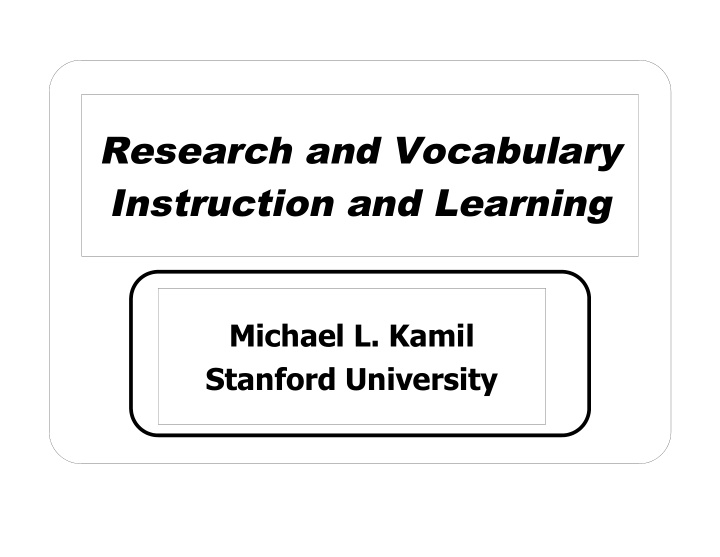



Research and Vocabulary Instruction and Learning Michael L. Kamil Stanford University
FACTS May 4, 2005 International Reading Association, San Antonio mkamil@stanford.edu
Types Types of of Vocabulary Vocabulary • Oral • Print • Receptive • Productive May 4, 2005 International Reading Association, San Antonio mkamil@stanford.edu
Whipple (1925) • Growth in reading power means, therefore, continuous enriching and enlarging of the reading vocabulary and increasing clarity of discrimination in appreciation of word values May 4, 2005 International Reading Association, San Antonio mkamil@stanford.edu
Davis (1942) Comprehension comprises two “skills”: Word knowledge or vocabulary and reasoning May 4, 2005 International Reading Association, San Antonio mkamil@stanford.edu
How Many Words Do We Know? • 2,500-25,000 words (typical 3 rd grade student) • 19,000-200,000 words (typical college student) May 4, 2005 International Reading Association, San Antonio mkamil@stanford.edu
Do the Math . . . To learn 175, 000 words between third grade and college a student would have to learn: about 17,500 words every year, or about 48 words every day, or about 115 words every school day May 4, 2005 International Reading Association, San Antonio mkamil@stanford.edu
What About Other At-risk Learners? • Good readers can read 1,000,000 words per year • Nagy & Anderson (1984) • Low SES: 1/3 to 1/2 the words of higher SES • Hart & Risely (1995) May 4, 2005 International Reading Association, San Antonio mkamil@stanford.edu
Theory May 4, 2005 International Reading Association, San Antonio mkamil@stanford.edu
A Theory of Vocabulary • Oral Language + Word Recognition = Print Comprehension • Decoding Oral Language • Oral Language Oral comprehension May 4, 2005 International Reading Association, San Antonio mkamil@stanford.edu
Research May 4, 2005 International Reading Association, San Antonio mkamil@stanford.edu
NRP Findings for Vocabulary • Number of studies analyzed N = 50 May 4, 2005 International Reading Association, San Antonio mkamil@stanford.edu
Results • 53 of 73 samples grades 3 - 8 • Different methods and effects for age and grade levels May 4, 2005 International Reading Association, San Antonio mkamil@stanford.edu
NRP Findings: Vocabulary Direct instruction improves comprehension • Computers • Keyword method • Indirect learning May 4, 2005 International Reading Association, San Antonio mkamil@stanford.edu
Findings (cont’d) • Multiple exposures • Rich contexts • Pre-instruction • Restructure the task May 4, 2005 International Reading Association, San Antonio mkamil@stanford.edu
Research Updates • PREL and LSS support for updating the database • 63 studies that meet NRP criteria • No NEW conclusions May 4, 2005 International Reading Association, San Antonio mkamil@stanford.edu
How Can Words Be Learned? • Indirect Experience • Explicit Instruction May 4, 2005 International Reading Association, San Antonio mkamil@stanford.edu
Table VI. Estimated Number of Repetitions Per Word Needed by Children of Varying Brightness at the Age of Beginning Reading. ( Redrawn from Gates, A. I. (1930). Interest and Ability in Reading. New York: Macmillan, p. 35) Range of IQ (CA Between 6.1 and 7.5 Number of Repetitions to be Provided Years at Beginning of Term) in Reading Course, i. e. Aside from All Incidental Learning. 120-129 20 110-119 30 90-109 35 80-89 40 70-79 45 60-69 55 May 4, 2005 International Reading Association, San Antonio mkamil@stanford.edu
Reading Practice • San Diego Recreational Reading Study • Quasi-Experimental • No General effects on reading • Limited effects on vocabulary, fluency May 4, 2005 International Reading Association, San Antonio mkamil@stanford.edu
What About ELLs? • Cognates in Spanish and English • 10,000 - 15,000 (estimated) • 1/3 - 1/2 the average educated person’s active vocabulary (Nash, 1997 ) May 4, 2005 International Reading Association, San Antonio mkamil@stanford.edu
What Does It Take? • Near native competence in Vietnamese • 1300 hours of instruction for adults • (Army Language School) May 4, 2005 International Reading Association, San Antonio mkamil@stanford.edu
• A child who spends about ten hours a day in school, in play, and with media in English might gain comparable, though seemingly natural and effortless, experience in 130 days (Walberg, Hase, and Rasher, 1978, p. 428) May 4, 2005 International Reading Association, San Antonio mkamil@stanford.edu
Conclusions • Vocabulary is critical • Early reading • Advanced reading • Explicit instruction is necessary • Some ELLs can leverage existing vocabulary May 4, 2005 International Reading Association, San Antonio mkamil@stanford.edu
Recommend
More recommend